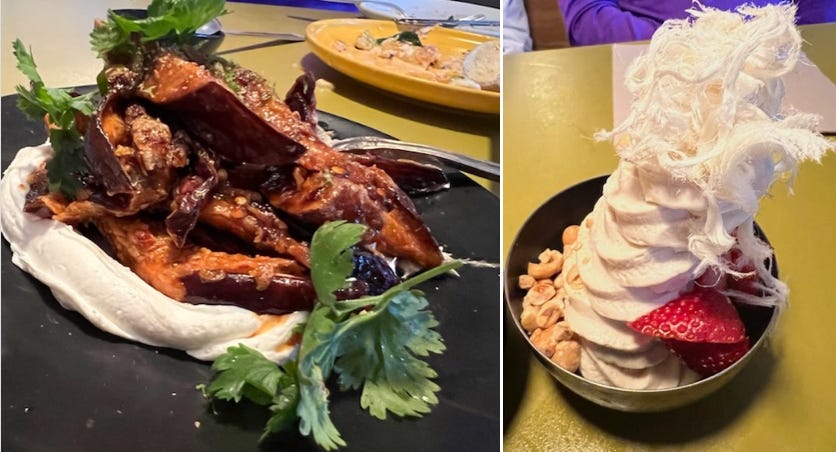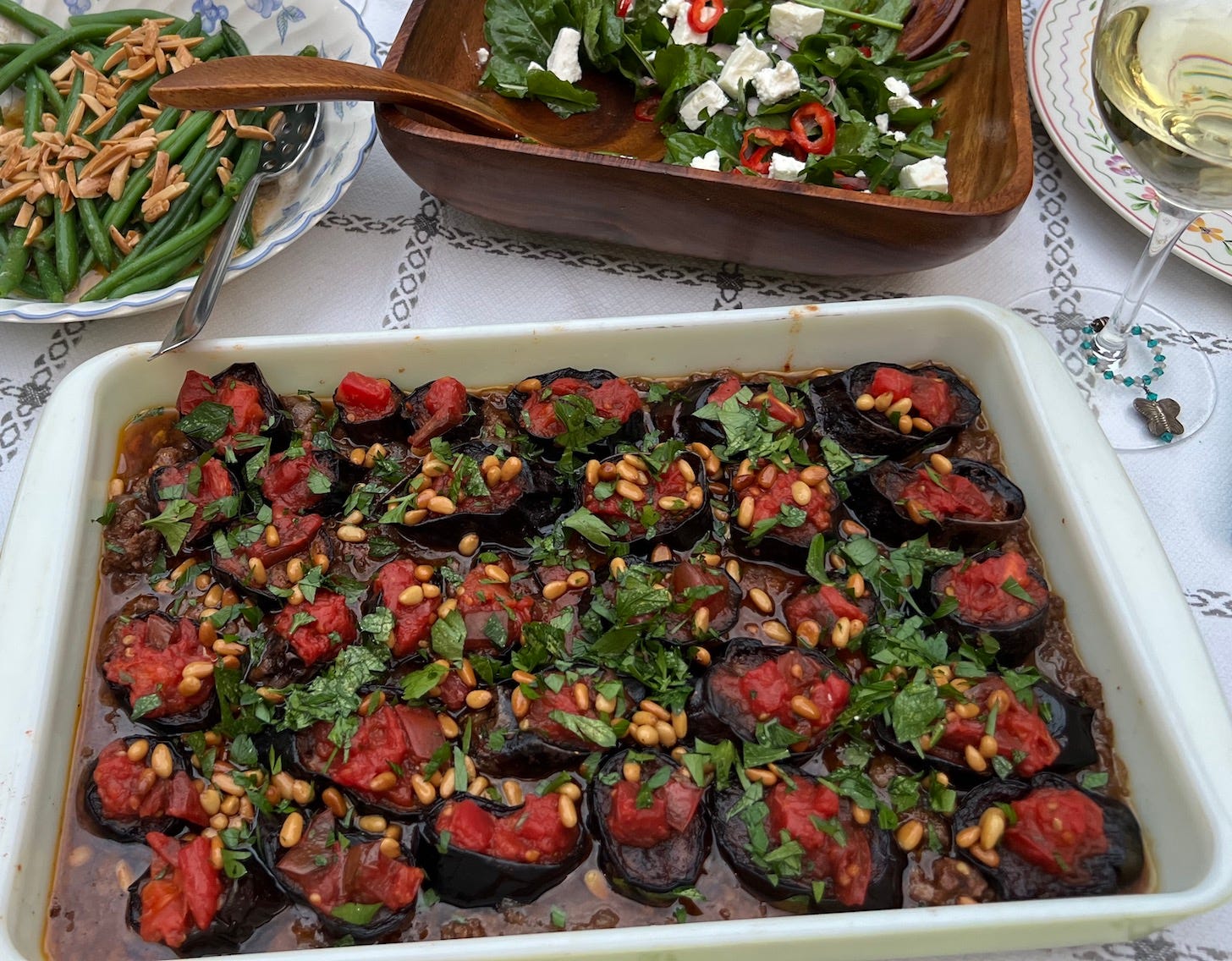I was raised in Georgia, occasionally eating the eggplant that my grandmother sliced into quarter inch rounds and dusted with flour before frying them into large gold coins. Later in college, I tried to love eggplant parmigiana, a staple in those potluck days of lentil stew and tofu, but inevitably the word “sponge” would come to mind. Only the strings of mozzarella seemed to save the day in that concoction. It was the same with my father’s famous ratatouille. It was a good side, but I never asked him for the recipe. It would be a couple of decades before I discovered the satisfactions of smoky babganoush made by the artisans at the Mediterranean Deli in Chapel Hill.
But grow my own eggplant? Nah.
Then came this September when my dear friend and the masterful cook Jim Harb honored us with a special welcome to Knoxville by making one of his mother Alice’s go-to Sunday dinners, Sheikh el Mahshi. It’s a Middle Eastern dish with many possible variations, he explained. Jim’s late parents, distinguished Tennesseans, emigrated from the Middle East in the 1910s. His spunky and unforgettable mother Alice, whom I once met, came from Syria. His father Wadie was from Palestine.
Over the years Jim has perfected his mother’s interpretation of Sheikh el Mahshi. Rather than stuffing elongated eggplants with a meat and tomato mixture, Alice’s rendering is a layered casserole. The base of the dish is spread with a spice-infused mixture of minced and slow-cooked lamb and onion. Then comes inch-thick eggplant medallions that have already been salted and long fried in high grade olive oil to a dark caramel. They are arranged on the bed of lamb and then dressed with a fresh tomato sauce, topped with pine nuts and Italian parsley. The dish was baked a bit before serving.
While the secret is in the Arab spices, which include coriander, cumin, cinnamon, and allspice, the magic comes in the way the eggplant’s spongey insides are transformed by carmelization in the frying to become a sweet, creamy custard held in place by the darkened skin. The fresh and chunky tomato sauce adds moisture and a bit of acid. This treatment fulfills the true botanical nature of eggplant, which, I learned, is not a vegetable but a fruit.
If you look online, most recipes call for the eggplant to be stuffed rather than stacked with the other ingredients. Jim thinks Alice knew better.
I also found that there is a similar Turkish dish also involving fried eggplant. It’s called “imam bayidi,” which translates to “the priest fainted.” The priest, says The Oxford Companion to Food, passed out because the taste of the eggplant was so heavenly. Other versions of the tale suggest the imam fainted when the cook revealed the price and generous amount of high quality oil used to fry the eggplant, which absorbs the oil like a sponge! Yet another version of the story suggests the imam ate so much he passed out. That was surely the temptation with Jim’s casserole!
Fast forward a week. Donna and I were in Manhattan at an elegant restaurant south of Central Park called Indian Accent. Now on a serious pilgrimage to sample more eggplant, I ordered a mid-course dish called “smoked eggplant bharta cornet, with goat cheese mousse.” See the photo below. It was intensely flavored, almost like a hearty chili, and the crunchy little cornets seemed to be fashioned of chickpea flour perhaps? One per person was enough.
The next night at a bustling, less formal establishment in Chelsea called Shukette, we ordered eggplant once more. This time it was sliced into wedges, the purple skin darkened to black, and the flesh carmelized to a fetching orange like a sweet potato. The hot and spicy wedges were piled in a fluffy nest of hummus and dressed with mint, chiles, dried tomatoes, and spears of Italian parsley. A winner among winners that night.
Later I found a New York Times review of the restaurant and this dish created by chef Ayesha J. Nurdjaja. Everything at this charcoal-smoke-scented restaurant was, “profligate with herbs and spices” as the Times put it, and superb. The only item that surpassed the eggplant was the finish—a bowl of soft serve tahini ice cream, accompanied by roasted peanuts and fresh strawberries, and topped by a frayed wig of spun sugar that would have made Phyllis Diller proud. OMG.

I could go on, but I won’t.
It was pure impulse back in May when we picked up a couple of eggplant seedlings to go along with a six pack of Shishito peppers for the summer garden in the Blue Ridge. We cut back on the kinds of tomatoes we planted this year in favor of the varieties that do best in the mountains. We also surrendered our hopes for okra. There’s just not enough summer heat at an altitude of 3,500 feet for it to flourish.
The eggplants have done well, however. They were slow to fruit, but sturdy in girth.The delicate blooms opened to show off a deep lavender, and the first fruits turned into oblong softballs. As we harvest the last of these eggplants, we will fry them in high grade olive oil and dust them with flavors from the new pouch of Arab herbs and spices.
We’ll plant more next year.







Beautiful photos and recipes. It makes me want to rush out for an eggplant.
Georgann, you never disappoint ! After reading your article I am going to fry my eggplant slices longer in a grape seed oil until they are, as you describe, like a custard.! The eggplant dishes look and sound mouth-watering ! Thank You !